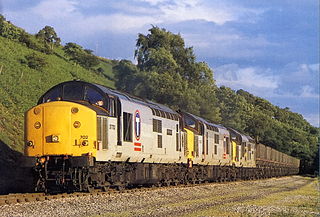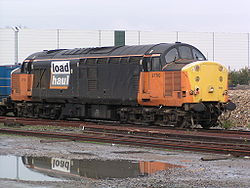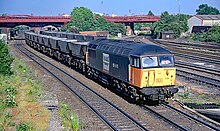
DB Cargo UK is a British rail freight company owned by Deutsche Bahn and headquartered in Doncaster, England.

The Class 66 is a type of six-axle diesel-electric freight locomotive developed in part from the Class 59, for use on UK railways. Since its introduction the class has been successful and has been sold to British and other European railway companies. In Continental Europe it is marketed as the EMD Class 66 (JT42CWR).

British Rail was the brand image of the nationalised railway owner and operator in Great Britain, the British Railways Board, used from 1965 until its breakup and sell-off from 1993 onwards.

Transrail was a trainload rail freight operator based in St Blazey, England, UK with a large operating area including Scotland, Wales and the west of England. It was formed in 1994 from part of British Rail's Trainload Freight division, as part of the privatisation of British Rail.

Mainline Freight was a trainload rail freight operator based in Islington, London, England with operations extending to Yorkshire in the north and Somerset in the west. It was formed from part of British Rail's Trainload Freight division as part of the privatisation of British Rail.

Railfreight Distribution was a sub-sector of British Rail, created by the division in 1987 of British Rail's previous Railfreight sector. It was responsible for non-trainload freight operations, as well as Freightliner and Intermodal services. In its early years, the division was occasionally referred to as Speedlink Distribution. It was later responsible for freight operations through the Channel Tunnel.

The British Rail Class 37 is a diesel–electric locomotive. Also known as the English Electric Type 3, the class was ordered as part of the British Rail modernisation plan. They were numbered in two series, D6600–D6608 and D6700–D6999.

The British Rail Class 92 is a dual-voltage electric locomotive, which can run on 25 kV AC from overhead wires or 750 V DC from a third rail. It was designed specifically to operate services through the Channel Tunnel between Great Britain and France. Eurotunnel indicates the Class 92 locomotive as the reference for other locomotives which railway undertakings might want to get certified for usage in the Channel tunnel.
Trainload Freight was the sector of British Rail responsible for trainload freight services. The division was subdivided into four sub-sectors; coal, petroleum, metals and construction.

The Class 67 locomotives are a class of Bo-Bo diesel-electric locomotives that were built for the English Welsh & Scottish Railway (EWS) between 1999 and 2000 by Alstom at Meinfesa in Valencia, Spain with drive components from General Motors' Electro-Motive Division.

The British Rail Class 60 is a class of Co-Co heavy freight diesel-electric locomotives built by Brush Traction. They are nicknamed Tugs by rail enthusiasts.

The British Rail Class 20, otherwise known as an English Electric Type 1, is a class of diesel-electric locomotive. In total, 228 locomotives in the class were built by English Electric between 1957 and 1968, the large number being in part because of the failure of other early designs in the same power range to provide reliable locomotives.

The British Rail Class 56 is a type of diesel locomotive designed for heavy freight work. It is a Type 5 locomotive, with a Ruston-Paxman power unit developing 3,250 bhp, and has a Co-Co wheel arrangement. Enthusiasts nicknamed them "Gridirons", due to the grid-like horn cover on the locomotive's cab ends fitted to nos. 56056 onwards. Under its Romanian railway factory nomenclature, the locomotive was named Electroputere LDE 3500, with LDE coming from Locomotivă Diesel-Electrică and the 3500 being the planned horsepower output.

The British Rail Class 58 is a class of Co-Co diesel locomotive designed for heavy freight. The narrow body with cabs at either end led to them being given the nickname "Bone" by rail enthusiasts.

The British Rail Class 59 is a fleet of Co-Co diesel-electric locomotives built between 1985 and 1995 by the Electro-Motive Division of General Motors for use in Great Britain. A total of 15 locomotives were built for three different operators.

A merry-go-round train, often abbreviated to MGR, is a block train of hopper wagons which both loads and unloads its cargo while moving. In the United Kingdom, they are most commonly coal trains delivering to power stations. These trains were introduced in the 1960s, and were one of the few innovations of the Beeching cuts, along with investment from the Central Electricity Generating Board (CEGB) and the NCB into new power stations and loading facilities.

Railfreight was a sector of British Rail responsible for all freight operations on the British network. The division was created in 1982 when BR sought to assign particular stock and management to the evolving requirements of freight traffic.

The history of British Rail's corporate liveries is quite complex. Although the organisation was associated with Rail Blue from the mid-1960s to the 1980s, a number of other schemes were also used, especially when it was split into operating units in the mid-1980s.
Speedlink was a wagonload freight service that used air-braked wagons and was operated by British Rail from 1977 to 1991.

The railway network in Great Britain has been used to transport goods of various types and in varying volumes since the early 19th century. Network Rail, which owns and maintains the network, aims to increase the amount of goods carried by rail. In 2015–16 Britain's railways moved 17.8 billion net tonne kilometres, a 20% fall compared to 2014–15. Coal accounted for 13.1% of goods transport in Britain, down considerably from previous years. There are no goods transported by railway in Northern Ireland.

























